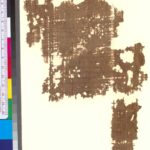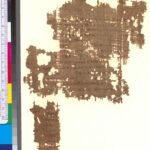| Artefact ID | 399 |
| TM ID | TM 61984 |
| Findspot (DEChriM ID) | - () | Class | Textual |
| Material | Papyrus |
| Writing medium | Codex |
| Text content | Literary |
| Language | Greek |
| Description | P.Mich. III 133 Two papyrus fragments from a papyrus codex containing Psalm 8.2-9 (verso) and 9.7-17 (recto). The ed. pr. notes that this sequence is suggestive of a codex of a single quire, with approx. 3,5 folios (lost) preceding this section. The fragments preserve more than half of the folio (originally approx. 33-35 lines), and contain 23 lines on the verso (contextually preceing the recto), and 25 lines on the recto. The text is written in paragraphs, and the format corresponds to Hebrew divisions. Insted of extending the separating space to line end, the scribe begins a new verse on the same line even where there is litte room; see ed. pr. There are traces of the title of Psalm IX at the top of the recto (only an ]αλμoς of ψαλμός remains), with possibly extra surrounding space as well as lines drawn above and below the text. Although the text is badly effaced and hardly legible, it is possible to discern from the parts that remain visible that the script was a careful book hand. The ed. pr. describes the letters as broad, without ornament and that letters which usually extend up/downwards (such as phi, pheta and rho), appear short in form. There is a nomen sacrum for κυριός "Lord", while οὐρανός "Heaven" and υἱός "Son" (perhaps also ἀνθρωπός "Man") remain uncontracted. |
| Selection criteria | Subliterary genre (Liturgical) |
| Date from | 200 |
| Date to | 399 |
| Dating criteria | Palaeography. Book hand with broad lettering. The ed. pr. suggests a date in the 3rd c. or even earlier, by comparison with the parchment Bibles of the 4th c. In the inventory of A. S. Hunt, the fragment is dated to the 3/4 c. |
| Absolute/relative date | Relative date |
| Archaeological context | Provenance and findspot are unknown. The fragment was purchased in Egypt in the spring of 1920 by profs. Bernard Grenfell and Francis Kelsey (University of Michigan) as part of a collection. The fragment was later placed by Arthur S. Hunt in the inventory of the University of Michigan in October, 1920; see ed. pr. |
| Accession number | Ann Arbor, Michigan University, Library P. 22 |


 Json data
Json data





